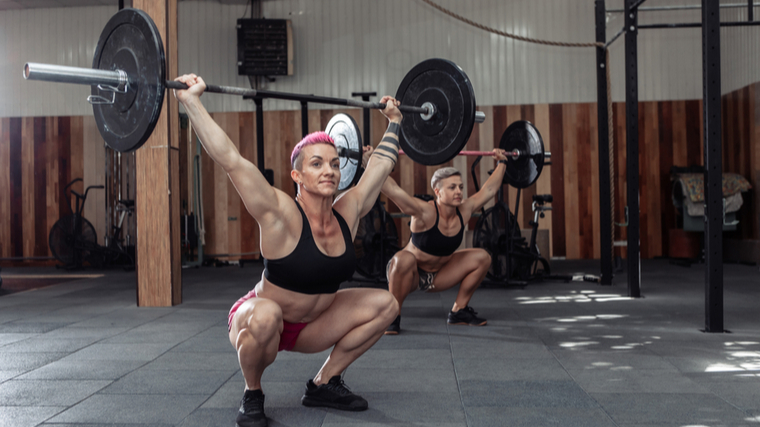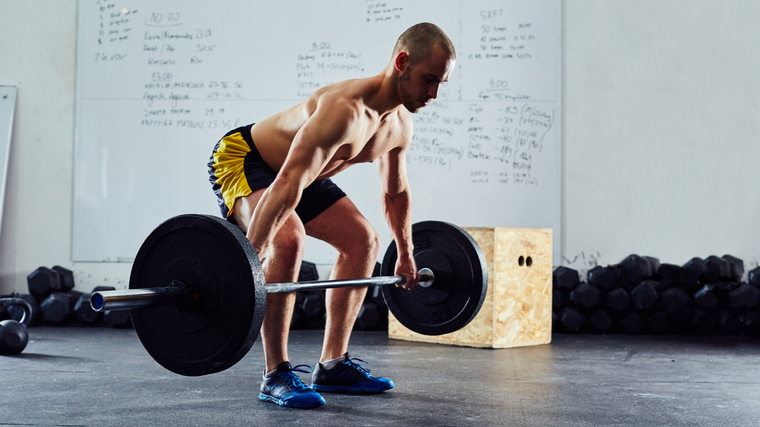Feeling Stuck in the Gym? Here’s How to Break Through Weightlifting Plateaus (original) (raw)
Weightlifting makes you stronger, but that pathway isn’t always linear. Eventually, you’ll likely find yourself going longer and longer between new personal records or bigger totals. This is the unfortunate inevitability of making a career in strength.
Everyone who trains long enough will someday hit a plateau — a point at which no matter what you do or how hard you work, things grind to a screeching halt in the gym.

Credit: Vladimir Sukhachev / Shutterstock
It’s easy to get frustrated with yourself if you’re stuck in a rut, but fortunately, there are plenty of ways to push past a training plateau. Plateaus are frustrating and far from ideal, but you can give these strategies a shot to overcome what’s holding you back and push yourself to new heights in the gym.
Plateau-Busting Strategies
- **Establish Your Goals
- Collect Training Data
- Adjust the Program
- Limit One-Rep-Max Testing
- Focus On Quality
- Enhance Your Recovery
- Up Your Effort
- Take Time Off
Establish Your Goals
When you’ve been lifting for a while, you inevitably become familiar with your own capabilities as an athlete. This helps you set precise goals for your training. Goal-oriented training enhances your progress in a way that haphazardly throwing barbells around simply can’t. Be mindful about what goal you want to achieve and how you want to get there instead of wandering through your sessions.
Any goal you set in the gym should be “S.M.A.R.T.”: (1)
- Specific
- Measurable
- Achievable
- Realistic
- Timely
Once you’ve fulfilled at least a majority of those criteria, also be sure that you’re covering some short-term and long-term goals. If you have a long-term goal of snatching 100 kilograms, you can set a short-term goal that contributes to that in the near future, such as hitting 90 kilograms for three reps.
If you find yourself at a plateau, assessing and reorganizing your goals can help to narrow your focus and enhance your productivity.
Collect Training Data
The more information you have about your training as a weightlifter, the better. Your performance in the gym is dynamic, so it’s important to continuously assess how your workouts are going. If you find yourself stagnating, referencing the data you’ve collected about yourself may help you identify the root of the plateau.

Credit: EM Karuna / Shutterstock
You can amass training data in many ways — even simply taking the time to observe how each rep or set physically feels can be useful in the short term. For long-term cataloging, consider recording notes about your workouts in a notepad or on your phone. Taking plenty of videos of your lifts also helps you by providing a reference for technique changes over time.
If you train in a specialty gym, a qualified coach can also evaluate your technique or performance for you.
Adjust the Program
Your program’s purpose is to keep you on track and help you perform effectively in the gym. If more than a few weeks go by without any form of notable progression in strength, technique, or endurance, you should take a look at your routine and reconsider if it’s working for you.
Weightlifting programs are meant to be followed over months instead of weeks, but that doesn’t mean you need to stick to something that isn’t serving your needs. You can change your workouts without changing your training goal and still make progress with new and improved strategies.
Start at the source of your plan. Talk with your coach to communicate a desire for changing your daily work, even if it’s just small revisions, such as how many repetitions you perform in the squat, or in what order you perform your exercises.
A good coach should be able to create a training agenda that best complements your needs. If you write your own programming, take the time to research the principles behind weight training and plan your workouts accordingly.
Limit One-Rep-Max Testing
Even though the sport of weightlifting measures its prowess by how heavily you can snatch or clean & jerk for one repetition, you shouldn’t make maxing out the centerpiece of your plan. If you’re plateauing in strength, pushing harder in that direction may not be productive and could lead to burnout or injury.
Plateaus in max-effort strength are common but in no way permanent. Knowing your limits is valuable, but you don’t need to test yourself too regularly. Doing so puts a lot of stress on your body and mind, so be tactful about when you load up your bar.
Your best bet for increasing strength is to work patiently with lots of volume and to trust that it will result in a bigger lift on the platform, even if you don’t see it happening in the gym.
Focus On Quality
When it comes time to test your strength, your best chance at success is to have the best technique. It’s difficult — but possible — to maintain picture-perfect technique when working with ultra-heavy loads. If you’ve got a new personal record on the horizon, double down on your attention to detail during every workout.
The technical attention you pay to your moderate-effort sets should manifest at maximum effort. You should perform the majority of your weightlifting training between 80 and 90% of your maxes, while focusing on tension, speed, and control.
If you find yourself at a plateau due to sloppy technique, there’s no shame in going back to basics and putting more effort into every rep you perform in the gym.
Enhance Your Recovery
Factors outside of the gym weigh heavily on your performance. If you find yourself at an impasse in the gym, the culprit may lie with your behaviors and habits outside the weight room. This is especially true if you’re an advanced lifter whose workouts demand a great deal of time and energy.
To avoid (or conquer) a training plateau, make your rest and nutrition as much of a priority as your workouts. You can use a process of elimination to identify the problem area in your athleticism — if you’ve got the right diet, you’re sleeping enough, and limiting external stress as much as possible, you’ll have a better idea of where to focus your attention to improve your performance.
Up Your Effort
No matter what lifting discipline you practice, there’s one principle at the center of strength training — you must work hard. While this may sound obvious at first, in practice, it’s actually quite possible that the source of your plateau lies in not working hard enough.
Some literature supports the idea that most trainees are relatively poor at assessing their own effort levels. In fact, most people consistently low-ball how hard they’re actually working in the gym. (2)
If you believe your weightlifting training is at a standstill, there’s a chance you might just have to increase the effort you’re putting in during your workouts. This doesn’t mean you have to slap on another five kilograms during your snatches, though.
Reducing rest times, adding an extra repetition, or including an extra set of squats or pulls are all ways you can increase workout intensity to break through a plateau.
Take Time Off
If you find yourself stuck in a severe-enough plateau that no conventional strategy is doing the trick, you might just have to take a break from weightlifting training altogether. It’s possible for training fatigue to build up slowly in a way that you don’t consciously realize until it severely dampens your performance.
Don’t be afraid to take time away from the barbell to replenish your motivation. Your gains won’t dry up and your muscles won’t wither away. In the meantime, you can work on a different form of physical activity such as calisthenics, bodybuilding training, or cardiovascular conditioning.
Remember that strength training is as much about your mind as it is your body. In the sport of weightlifting, one cannot work effectively without the other. Your workouts should be a source of joy, not stress.
Programming Strategies to Avoid a Plateau
If you’re worried about hitting a plateau, you can take certain actions in your workouts to help mitigate that risk. Here are a few suggestions to implement into your weightlifting routine that may help stave off a stall in progress.
Build Your Base
For a bigger peak, go back to the base. Most good weightlifting programs have a “base cycle” in which you develop the various qualities that contribute to overall athleticism. Think endurance, flexibility, technique, muscularity, and so on. Even as you progress through your program, you should still focus on the basics.
Include a few sets each session with just the empty barbell to refine your technique. Don’t be lazy about your warm-up reps, and don’t tack on weight to your working sets if it compromises your technique. Be diligent about your strength work and do plenty of squats and pulls in the five to eight rep range.
Start a Strength Cycle
The snatch and clean & jerk require tremendous amounts of general leg strength. To that end, don’t skip out on your strength movements. After you complete a base cycle, lean into developing full-body strength before you test your maxes in the competition lifts.

Credit: baranq / Shutterstock
You can start a strength cycle at higher repetitions like eight to 10, and gradually decrease down to as low as one to three reps in exercises like the squat, press, or various types of deadlifts. Building a strength reserve should translate well to your main movements.
Get Complex
A weightlifting complex is a series of different lifts strung together over the course of one set. They’re considered a form of cluster work. For example, a complex designed to target the clean & jerk could be:
Performed back-to-back without dropping the barbell. They’re a great way to increase workout density and stimulate specific aspects of your training quickly. You can swap out which movements occupy the complex to introduce variety to your training and avoid the monotony that may contribute to plateauing.
Accessorize
In weightlifting, accessory movements are secondary exercises that target your individual weaknesses. Accessories typically work the smaller supporting muscles that the snatch or jerk don’t adequately stimulate — the biceps, triceps, rhomboids, obliques, and more. The right accessory exercises for weightlifting can make all the difference when it comes to avoiding a plateau.
Since accessory training involves working these smaller muscles to failure, you should hit your accessory lifts at the end of your workout, with light-to-moderate weights and higher repetitions.
Wrapping Up
Strength gains do not always present plentifully, but this should not discourage you from continuing your training. Reaching impressive levels of strength in weightlifting takes a lot of practice and even more time. Your strength levels are bound to fluctuate throughout your career.
There will certainly be periods where it feels like you’re putting in more than you’re getting out, but you must be willing to put in the effort to overcome these plateaus, despite how mentally draining they feel. Changing your program, prioritizing recovery, or taking a brief intentional break are but a few ways to break past a plateau and set yourself up for long-term success in the sport.
References
- Healy, Laura & Tincknell-Smith, Alison & Ntoumanis, Nikos. (2018). Goal Setting in Sport and Performance.
- Barbosa-Netto, S., d’Acelino-E-Porto, O. S., & Almeida, M. B. (2021). Self-Selected Resistance Exercise Load: Implications for Research and Prescription. Journal of strength and conditioning research, 35(Suppl 1), S166–S172.
Featured Image: Celso Pupo/Shutterstock